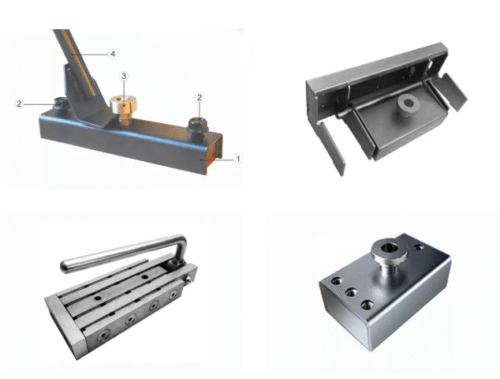Modern production of precast concrete products is increasingly switching to automated technologies. One of the key areas of development has been the magnetic fixing system for the production of precast concrete products, which allows for a radical increase in the accuracy and speed of formwork assembly. This technology has become the answer to the industry's need to reduce labor intensity and improve product quality stability.
Today, magnetic fastening systems are being implemented at leading reinforced concrete product factories, replacing outdated mechanical fastening methods. This is not just an innovation — it is a tool for optimizing production processes and increasing efficiency.

The essence of the technology: reliable fastening without mechanical restrictions
Magnetic fastening technology is based on the use of powerful industrial magnets that hold formwork elements and mold-forming parts on a metal base. This system ensures precise positioning of the molds and eliminates displacement during concrete vibration compaction.
Thanks to their simple design and high holding force, magnets eliminate the need for welding and bolted connections. This makes the process of assembling and disassembling molds much faster and safer.
The magnetic fastening system is used for both horizontal molding of slabs and panels and for vertical molding tables. It can be easily adapted to specific production tasks and allows the configuration to be changed without additional equipment.
Practical application: effective in action
In the reinforced concrete industry, the magnetic fixing system is used in the manufacture of wall panels, staircases, floor slabs, and facade elements.
Magnets fix the formwork on the molding table, ensuring the stability of the structure when pouring the mixture. After the concrete has set, the fasteners are easily removed without damaging the surface of the product and without requiring additional effort from the personnel.
This technology is especially in demand on mass production lines, where mold sizes often change. Magnetic systems allow you to quickly reconfigure equipment and start a new batch without downtime.
Advantages and benefits of implementation
The implementation of a magnetic fastening system for the production of reinforced concrete products provides tangible benefits in the daily work of the plant:
- acceleration of all stages of form assembly and disassembly,
- increased accuracy and repeatability of product geometry,
- reduction of rejects and defects due to stable positioning,
- reduction of manual labor and fastener costs,
- increased line productivity and overall finished product output.
In addition, the use of magnetic fasteners makes production more flexible and modern. The equipment quickly adapts to new products, which is especially important for companies working on individual projects.
Confidence in the result and a ready-made turnkey solution
The magnetic clamping system for the production of reinforced concrete products is a real tool for increasing the efficiency, quality, and speed of reinforced concrete production. It combines technological efficiency, reliability, and ease of maintenance, making the production process more predictable and controllable.
TDM Engineering Oy offers a complete range of solutions for integrating magnetic systems into existing lines. This equipment is adapted to the specifics of the Russian market, with guaranteed durability and technical support.
If your goal is to reduce costs, increase output, and ensure consistent product quality, now is the time to switch to a modern format. Contact the company's specialists and get an effective solution that will allow your reinforced concrete production to work faster, more accurately, and more profitably.
Frequently asked questions (FAQ)
1. What is a magnetic fixing system in the production of reinforced concrete products?
A magnetic fixing system in the production of reinforced concrete products is a technological solution that uses industrial magnets for quick and reliable fixing of formwork elements. It replaces welding and bolting, increasing geometric accuracy and reducing labor costs at all stages of molding.
2. Where is the magnetic fixing system used in the production of reinforced concrete products?
This technology is used in factories that produce prefabricated panels, staircases, floors, columns, beams, and other reinforced concrete products. The system is suitable for both horizontal molding tables and vertical structures, making it versatile for most production lines.
3. What are the advantages of introducing a magnetic fastening system in the production of reinforced concrete products compared to traditional methods?
The main advantages are faster assembly and disassembly of molds, increased accuracy, reduced fastening and maintenance costs, and fewer defects. The system also provides flexibility when changing product configurations and makes work easier for personnel.
4. Is magnetic fastening safe when working with heavy molds?
Yes, modern magnetic systems are designed for heavy loads and have high holding force. They securely fix the formwork even when there is vibration during concrete compaction. When used correctly, there is no risk of displacement or loosening of the fastening.
5. Can the magnetic fastening system be integrated into existing reinforced concrete plant equipment?
Yes, most solutions can be adapted to existing molding tables and equipment. This allows the magnetic fastening system to be implemented without a complete modernization of the line, with minimal costs and production downtime.
6. Why choose an industrial magnetic fastening system from TDM Engineering Oy?
TDM Engineering Oy's solutions are designed with the characteristics of modern production lines in mind. They are distinguished by their durability, high magnetic force, and well-thought-out ergonomics. The manufacturer offers comprehensive implementation — from magnet selection to staff training, making the technology a ready-made tool for increasing the efficiency of reinforced concrete production.


